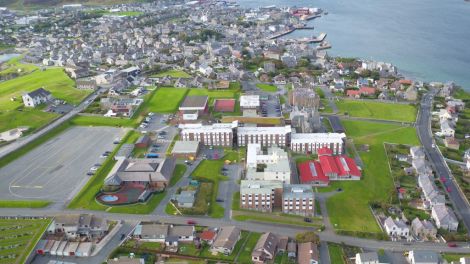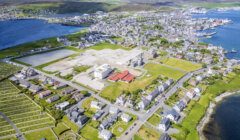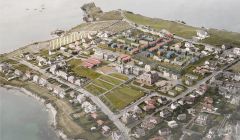Council / Knab redevelopment project takes step forward after vote
SHETLAND Islands Council (SIC) is to press ahead with the initial stages of redeveloping the old Anderson High School site – but concerns have been raised over the increased cost.
After council convener Malcolm Bell cast a deciding vote during a meeting of elected members on Wednesday, the SIC approved additional funding of £2.374 million for the project.
While elected members were supportive of the plans for the site, concerns were raised in the chamber over how the price tag for demolition and other services to prepare the site for development had sharply increased from the approved budget of £1 million set last year.
An amendment was proposed by Shetland South member George Smith for the decision to be deferred until the council next discussed its asset investment plan, which is slated for March.
But when a motion to approve the increased budget went to a vote against Smith’s amendment Shetland’s 22 councillors were split down the middle, with Bell having to cast the deciding vote in his role as meeting chair.
A report to elected members showed that after more detailed assessments the estimated cost of demolition of the majority of the buildings on site had risen from £1 million to an estimated £2.454 million.
There are hopes for all demolition to be complete by mid-2022.
A further £920,000 has been added to estimates to cater for professional services relating to designing infrastructure, as well as internal resources.
Councillors were told that the complex project to rejuvenate the Knab site with housing and other uses could take 10 years to reach to completion.
A bid for £10 million of funding has been submitted as part of the UK and Scottish governments’ islands deal, covering a range of initiatives on site such as low carbon house design, student accommodation and a creative industries hub.
Become a member of Shetland News
Lerwick councillor John Fraser sought clarity on how the estimates had risen by millions, with borrowing costs added on top.
Fellow town member Amanda Hawick also pressed on council officials on the costs, warning that there was already a “chronic draw down on our reserves”.
Council chief executive Maggie Sandison made the case that the project would bring in future income, including through housing rent, while demolition would result in significant savings from the existing rates bill.
She said the aim to have “future fit” housing on site which would, for example, go far beyond existing efficiency regulations, could be downsized if the islands deal funding bid failed.
After there appeared to be little consensus on the true cost of the initial stages taking into account borrowing costs, council officials agreed to give elected members more details on the history of the process.
Development director Neil Grant also pointed out that funding for housing would come from the Scottish Government.
Assets, commissioning and procurement manager Robert Sinclair said the council had spoken to other local authorities about cost estimates for demolition, including Orkney, and the tendering for taking down the old Eric Gray centre gave officials fresh knowledge of prices.
He also told councillors that engagement with folk living around the area was ongoing, with two newsletters for instance delivered to residents so far.
Development committee chairman Alastair Cooper said the “iconic” project will be the biggest the council will oversee in the next decade, and moved that members approved what was asked of them.
“We really have no other option than to accept the figures,” he said, adding that pressing ahead would give clarity to council officers working on the project.
While George Smith said he was supportive of the redevelopment, the south councillor felt the decision should be delayed until members have discussed an upcoming plan on asset investment between 2021 and 2026 first.
“I remain concerned that we have reports coming ahead of strategic decisions,” he said.
“My concern is about the timing of the decision.”
Smith said there appeared to be confusion in the chamber as to the true cost of the first stages of the Knab project, and expressed worry that as a result councillors could be agreeing to fund a “blank cheque”.
West councillor Catherine Hughson added that she felt pushing through projects like the Knab redevelopment could see smaller projects in the community lose priority.
The report to members also revealed that the council has been engaging with Shetland Arts on possible collaborative use of the buildings which will be retained, in particular the Anderson Educational Institute.
It says the arts agency is engaged along with the council, in pursuing funding through the Islands Deal for a “creative industries hub” in the institute building.
Councillors were asked to approve delegated authority to council officers to agree terms with Shetland Arts for the occupation of the Anderson Educational Institute building.
But Cooper’s motion which won the day said that “provisional” terms would be agreed, following an interjection from Shetland Central member Moraig Lyall.
There were some question marks about the future use of the institute, with councillors keen to hear more details.
Become a member of Shetland News
Shetland News is asking its readers to consider paying for membership to get additional perks:
- Removal of third-party ads;
- Bookmark posts to read later;
- Exclusive curated weekly newsletter;
- Hide membership messages;
- Comments open for discussion.
If you appreciate what we do and feel strongly about impartial local journalism, then please become a member of Shetland News by either making a single payment, or setting up a monthly, quarterly or yearly subscription.
























